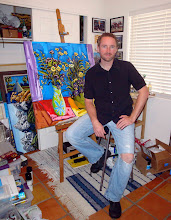This week I am working on a 30 x 48 inch vertical Saguaro landscape for some clients in Scottsdale, AZ. I was never a great fan of narrow, vertical paintings but I find that I like them better and better the bigger the size gets. A 30 x 48, trusting you place the subject matter on canvas well, is a large, plunging vertical and it creates a great feel of size and verticality.
I wanted to be honest with folks reading this blog that the reason there are not thousands of blog posts by me is that I typically reserve my comments for when I actually have something that I think may be useful to say. These people who tweet or blog every time they brush their teeth or take out the trash just drive me nuts. I think that anytime you write something you should at least litmus test it in your mind to see if it's either vaguely amusing - therefore providing a little brightness to someone's day who could use it - or it should be useful and shed a little light.
I have written at great length about originality in art, and the need to seek and express new sensations that are both personal and universal at the same time. (Frequently, if a piece of music, literature, or art is only one of those things - it's not very good, in my opinion.) A couple of weeks ago I found myself enthralled by a book about the 1789 mutiny on the ship The Bounty. The book was the more recent title by Caroline Alexander. Though the book has some long, tiresome descriptions of the sailors captured and put on trial for their roles in the mutiny...what interested me most was what happened to the mutineers who went on to settle Pitcairn Island - a remote island outpost in the Pacific. It was very interesting to read about how a group of Englishmen, with some Tahitians that they essentially kidnapped - created a small society on this remote island, far detached from any part of what was the modern world at the time. What followed after those men settled on Pitcairn and burned the ship - was a fractious period where many of them killed one another, or were killed by the Tahitians that they settled the island with.
What I am getting at here was the realization that I had to admit to myself that one of the most interesting periods of history, in my eye, was the colonial period. One favor, however, that modern history and a common regard for human rights has given to us is to also realize that for Europeans to settle in places like America, Africa, South America, and the South Pacific, the wholesale disenfranchisement and often murder of the natives was required, and even celebrated by some. This should not be painted for anything other than what it was. Jared Diamond's fabulous book "Guns, Germs and Steel" did a great job telling this story. However there did emerge from the colonial period in history something unique and of use to everyone, including artists. The entering into spaces and places unknown to the Western World.
It is not, of course, that natives of all continents didn't do this as well. They have always done this - what was compelling in this case was what Europeans did when they ventured into new places with the technologies of their ocean going ships and the written languages and narratives that could capture and record what the far off world was really like, for the enthrallment of people of all nations.
If I had been alive then I might have been a willing participant in the age of exploration - but what was revealed to learned eyes came at the cost of the genocide and subjugation of entire regions full of native peoples. Whatever light was shed, cast a pall of darkness at the same time. I would have loved to explore and see such amazing places as they were being revealed - but I could not have raised my hand in anger against anyone who was there before me. Europeans had, far too often, convinced themselves that any kind of horror was justified if so called 'civilized' men were the culprits.
I should say also that my interests in 'unknown spaces' has found a great deal of enjoyment in the exploration of space and the planets. When a space probe opens it's lenses for the first time on planets like Mars, or moons like Titan - I am one of the first to want to see what they see.
Even when I was a kid I would explore wooded areas around where I lived for miles and miles. Until I knew every tree, and even until I could guide my friends great distances through the woods in the dark. It was all great fun to me...
However much a stretch the comparison might be - I think it is still useful. The same drive that would make someone disembark from a ship, or travel with Lewis and Clark across the American West, or penetrate the deepest jungles of Africa or the Pacific - the same interest and curiosity should exist within the heart of the artist. With all the world of knowledge at our backs, it seems to me that the canvas is still an unknown space, and we are getting to know our world, interior and exterior, each time we set out to explore that imagery.
Happy Holidays to Everyone!
www.neilmyersart.com
Wednesday, December 14, 2011
Subscribe to:
Posts (Atom)
